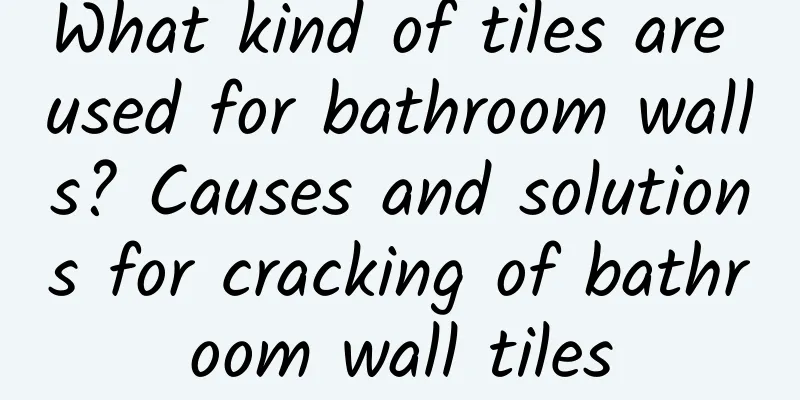What kind of tiles are used for bathroom walls? Causes and solutions for cracking of bathroom wall tiles

|
Since there is a lot of moisture in the bathroom, it is recommended to choose tiles with patterns, textures or matte surfaces when laying wall tiles, because this kind of tile has a non-slip effect and is safer when bathing. At the same time, it is recommended that the colors of bathroom tiles should not be too messy when choosing bathroom tiles, which can easily cause visual fatigue. There are many reasons for the cracking of bathroom wall tiles. One of the natural reasons is that the wall deforms and squeezes the tiles. To remedy the hollowing of bathroom wall tiles, you need to look at the hollowing situation. If it is hollow at the corners, you need to shovel around the tiles and knock on the tiles while pouring cement. If it is a trace of hollowing, you can use epoxy injection glue and inject the epoxy injection glue on the back of the tile. If it is hollow in the center, you need to pry open the tiles and prepare new tiles for laying. Contents of this article 1. What kind of tiles should be used for bathroom walls? 2. Causes and solutions for cracking of bathroom wall tiles 3. Remedies for hollowing of bathroom wall tiles 1What tiles to use for bathroom wallsThe bathroom wall uses tiles with low water absorption, which will increase the durability of the tiles. It is best to drip water on the back of the sample tile to test the water absorption before buying the tiles. It is recommended to use high-density wall tiles in the bathroom, so that the wall tiles are not easy to break and are easy to clean. At the same time, when laying wall tiles, it is best to choose tiles with patterns, textures or matte surfaces. The biggest difference between the bathroom and other spaces is that there is too much moisture, so you can use tiles with low water absorption on the bathroom walls, which will also increase the durability of the tiles. When buying tiles, you can drip water on the back of the sample tile. If it penetrates slowly, this tile is more suitable for the bathroom. It is not suitable to use too fragile and brittle bricks in the bathroom, including glazed tiles, polished tiles, etc. It is recommended to use high-density wall tiles in the bathroom. After getting the sample tiles, first check whether the brick surface is intact. At the same time, when knocking on the tiles, the crisper the sound, the higher the density, and this kind of tile can be used for paving the bathroom. 2Causes and solutions for cracking of bathroom wall tiles1. Natural causes There are many reasons for the cracking of bathroom wall tiles. In many cases, the cracking is caused by the deformation of the wall, which causes the wall tiles to be squeezed and deformed. Generally, the cracks on the surface of tiles squeezed by the wall are regular horizontal, vertical or oblique cracks. Therefore, the load-bearing capacity of the wall should be improved before laying the wall tiles. 2. Human factors The cracking of bathroom wall tiles may also be caused by improper handling during tile laying, such as tiles not being soaked in water, tiles not leaving gaps, unqualified adhesives, etc. It is recommended that when laying bathroom wall tiles, you must follow the steps step by step and lay them according to the actual situation of the bathroom. In fact, the cracks in the bathroom will not affect the use, but it will affect the appearance of the wall tiles. Therefore, it is recommended to use professional tile caulking agent to fill the gaps, which not only has a fast bonding speed but also has a high bonding degree. However, if there is no professional tile caulking agent at home, you can also use toothpaste instead, but it can only be used for white tiles. 3How to fix hollow tiles on bathroom wallsIf you find that the bathroom wall tiles are hollow, tap the tiles with your hands to confirm the hollow situation of the tiles, and then deal with it according to the actual situation. First, use a shovel to scrape open the hollow tiles, and then use relatively thin cement to pour into the scraped tiles. While pouring cement, you should also tap the tiles to facilitate the cement to be poured in. If there is only a slight hollowing problem, you can directly pour epoxy injection glue into the hollow area, inject the glue into the back of the hollow brick and then paste it. Note that this situation is only suitable for bricks with minor hollowing problems. If the bricks with serious hollowing cannot be glued, it is recommended to remove the tiles and paste them again. If the center of the tile is hollow, this is the most troublesome one, because the tile must be pried off to solve the problem. Use a hammer to smash the middle of the tile and slowly take it out. At the same time, prepare tiles of the same size and pattern for laying. Note that cement must be prepared before laying, and do not touch water in the near future after the tiles are laid. |
<<: How to choose tiles? Do tiles have radiation? What are the tips for choosing bathroom tiles?
>>: What are some tips for cleaning wax on tiles? Tips for mopping tiles clean
Recommend
Symptoms before menstruation
Some female friends will experience many symptoms...
Period delayed for a week and no pregnancy
Menstruation is a very important physiological ph...
How is the warty hyperplasia of the vulva
Traditional Chinese medicine and Western medicine...
How long should I wear the bandage after breast fibroid surgery?
Breast fibroids are a relatively common female ph...
How many minutes does it take to perform surgery on cervical erosion?
In today's society, most women have had sex b...
What are the benefits of eating dried noodles? Do you need to cook dried noodles for stewing?
Some people like to eat dried noodles. Dried nood...
Is female cystitis serious?
I believe that many women will notice that they s...
Why do women have two periods in one month?
Although having two periods in a month sounds imp...
Do you know how to massage your shoulders and neck for fatigue?
In life, many female friends will experience shou...
What should I do if I get bronchitis during pregnancy?
When you become a mother, you will truly know wha...
Knowledge on the recurrence rate of uterine fibroids
For many female friends, gynecological diseases h...
What is the recipe for the Old Beijing Lamb Rib Hotpot? What is in the Lamb Rib Hotpot?
Typical hot pot ingredients include various meats...
Characteristics of a simple and pure woman
Girls with simple minds are popular, but in real ...
How many days before the angiography can I not have sex?
Everyone must be familiar with contrast examinati...
What to do if you have stomach pain during your period
Many girls will experience menstrual pain during ...









